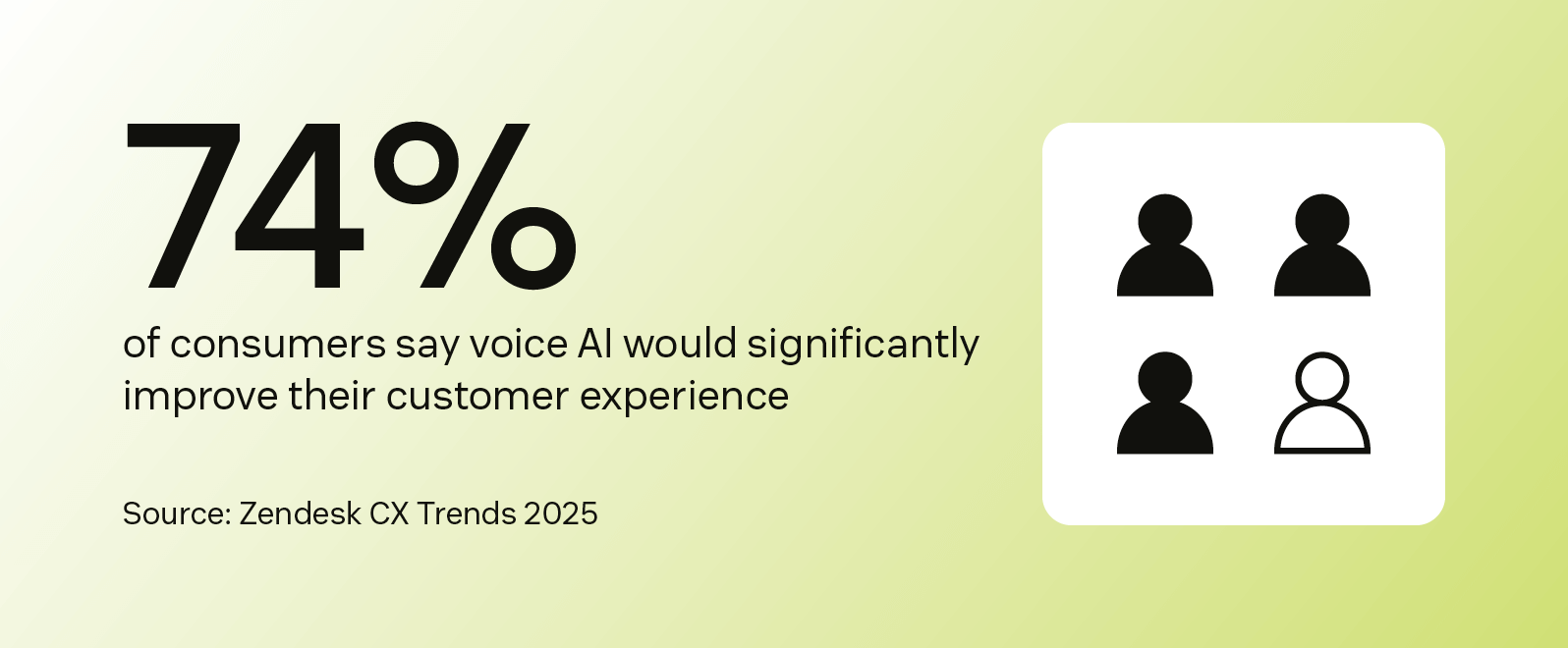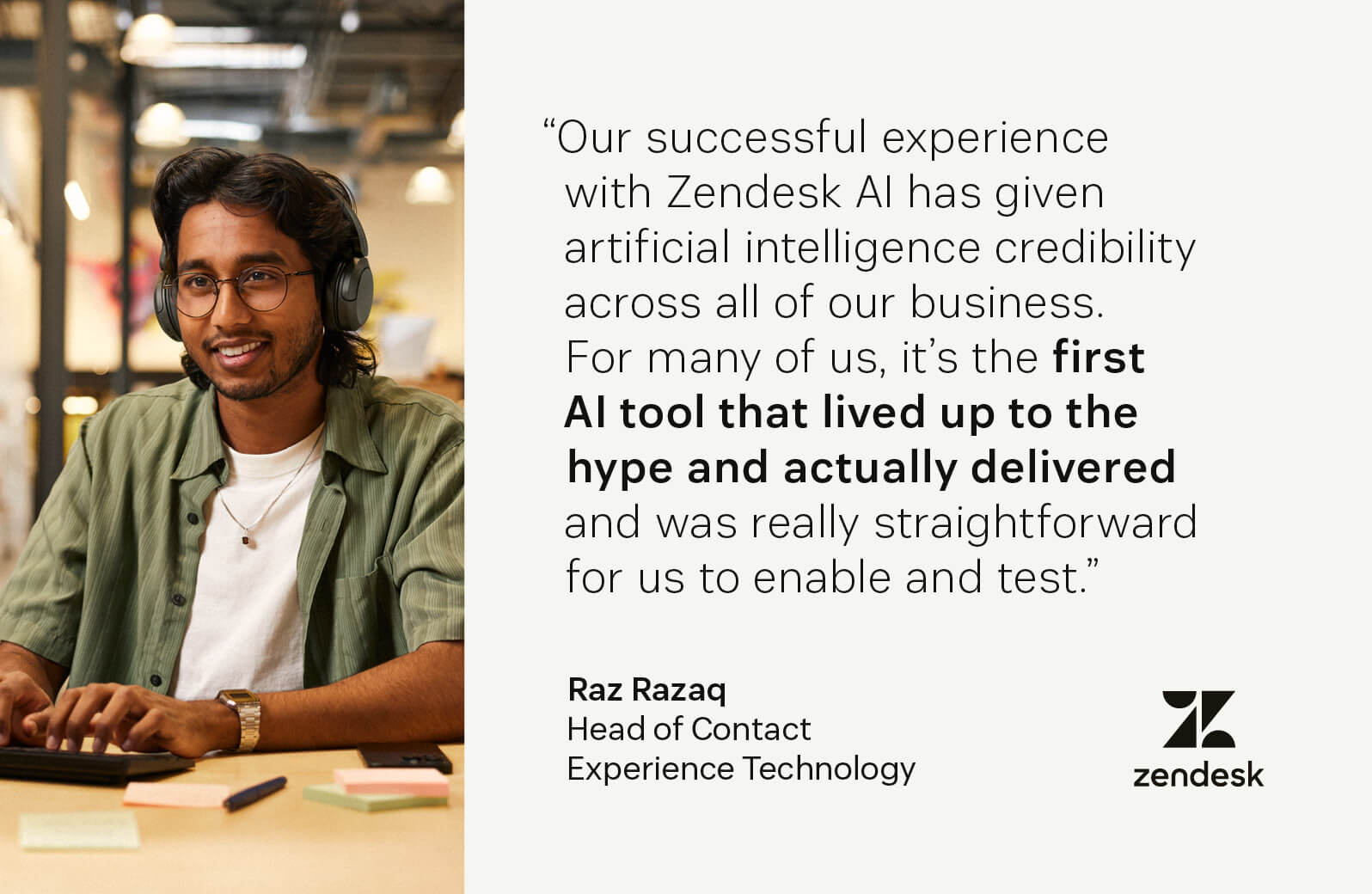Article • 10 min read
AI in contact centers: How technology is shaping the CX
Implementing AI in your contact center can transform your CX and empower your team to operate more efficiently. Learn more about this important technology.
Candace Marshall
Vice President, Product Marketing, AI and Automation
최종 업데이트: August 7, 2025
With everything from groceries to rideshares available at the push of a button, today’s customers have higher expectations for service than ever before. Yet, according to Zendesk benchmark data, 62 percent of customer experience (CX) leaders feel they’re falling short of meeting these expectations.
Closing this gap requires intelligent and scalable solutions, which is exactly where artificial intelligence (AI) comes in. This article will explore how leveraging AI in contact centers empowers teams to provide more efficient service that never sacrifices quality.
More in this guide:
- Why is AI important in customer service?
- Key AI contact center technology
- Benefits of implementing AI in a contact center
- Challenges of implementing AI in contact centers
- 3 AI contact center examples
- 5 best practices for implementing AI in contact centers
- Build a smarter contact center with Zendesk AI
Why is AI important in customer service?
AI is important in customer service because it makes the entire experience more efficient for agents and customers.
Until recently, contact centers relied heavily on human agents, often resulting in long wait times and inconsistent support. But today’s customers expect instant solutions with minimal friction, which is challenging to deliver at scale through human effort alone.
To meet these rising demands, many organizations are turning to AI in contact centers to eliminate repetitive work and help agents focus on more high-value interactions. The result is a more streamlined and responsive experience that keeps customer satisfaction front and center.
Key AI contact center technology
AI capabilities are now built into many modern tools, including contact center as a service(CCaaS) software, making it easier to improve speed and consistency across every channel. Here’s a closer look at some of the specific AI technologies modernizing contact center operations.
1. AI-powered voice

AI-powered voice uses speech recognition and natural language processing (NLP) to understand and respond to customers naturally. This enables businesses to boost call response time while still maintaining a personal touch. According to the Zendesk Customer Experience Trends Report 2025, 74 percent of consumers feel this kind of voice AI would significantly improve their overall experience.
Zendesk voice takes this a step further by providing instant customer insights to agents during calls, helping them respond confidently. It also allows organizations to direct and route calls and support tickets across all channels from a unified agent workspace. This level of integration helps reduce complexity behind the scenes, so agents can stay focused on providing better support.
2. AI agents
AI agents are the next generation of AI-powered bots designed to handle complex tasks without human intervention. In contact centers, they can provide instant support across all channels, making them a natural fit for an omnichannel contact center strategy. What sets them apart is their ability to take action, whether answering personalized questions or completing tasks like issuing refunds, all without human input.
With Zendesk AI agents, businesses can automate up to 80 percent of requests. Since the AI agents are purpose-built for CX and trained on billions of customer service interactions, they generate fast and accurate responses while freeing up human agents for higher-value work.
3. AI copilot
Unlike fully autonomous AI agents, an AI copilot is built to work alongside support teams, assisting them throughout different tasks. It supports agents behind the scenes to enable more personalized service.
Zendesk AI copilot is purpose-built to address the specific challenges support agents face daily. This tool anticipates customer needs and offers intelligent response suggestions based on each query. And with its simple setup, it fits naturally into existing workflows, helping agents work faster and more confidently.
4. Intelligent routing
Intelligent routing uses machine learning to direct customer queries to the most appropriate agent or channels. One common use case isintelligent call routing (ICR), which collects information about the caller and analyzes it to route the call accordingly.
This approach reduces transfers and boosts first-contact resolution for a better overall customer experience. It also makes it easier for organizations to scale service quality without adding unnecessary headcount.
5. Quality assurance
Quality assurance (QA) is essential for maintaining high service standards and guaranteeing positive customer experiences across the board. Traditionally, QA involved manually reviewing interactions to identify gaps, but AI tools like Zendesk QA now automate much of this work.
Zendesk QA analyzes every customer interaction and assigns a score to pinpoint any issues or coaching opportunities. This automated process cuts review time by 80 percent and helps ensure more consistent, high-quality support across every channel.
6. Workforce management
In contact centers, workforce management systems make sure the right agents are available at the right time to meet customer demand. AI automates this process by streamlining tasks like forecasting, scheduling, and optimizing agent workloads.
For example, Zendesk WFM uses AI to analyze past contact volume data to predict staffing needs, reducing overtime costs and wait times. It even lets you track agent activity in real time, providing precise performance metrics that inform more thoughtful scheduling and coaching decisions.
Benefits of implementing AI in a contact center
As more businesses adopt AI, contact centers will become more intelligent and responsive.
Some of the specific benefits AI brings to contact centers include:
- Improved CX: With faster response times and more natural interactions, AI makes every touchpoint feel easier and more intuitive for customers.
- Increased efficiency: AI boosts efficiency across nearly every aspect of a contact center’s operations, from automating tasks to providing real-time assistance, leading to a more productive workflow overall.
- Enhanced customer insights: When contact centers use AI tools to analyze interactions, they get detailed insights about customer sentiment and patterns, giving businesses a clearer direction for continuous improvement.
- Reduced costs: Automating contact center tasks with AI significantly reduces labor costs without compromising service quality. These efficiency gains also support long-term savings and operational scalability.
AI is quickly becoming the new standard in customer service, and the difference is noticeable. Our CX Trends Report found that 70 percent of consumers say they can already tell which companies are using it well, signaling a growing divide that businesses can’t afford to ignore.
Challenges of implementing AI in contact centers
While AI offers major benefits for contact centers, it isn’t without its challenges. One of the most common barriers is employee resistance, often driven by concerns over job security or unfamiliar tools. That’s why Zendesk places heavy emphasis on designing technology to enhance the role of human agents, not replace them.
Another concern is maintaining a human connection in customer service. AI excels at speed and scale, but it can’t fully replicate the empathy and nuance of a real person.
To address this, Zendesk AI is built on billions of real-world support conversations, giving it a deeper understanding of customer sentiment. It’s designed to handle routine requests, so agents can focus on the more complex issues that require a human touch.
3 AI contact center examples
Many companies already see strong results from bringing AI into their contact center operations. Here are a few examples of what that can look like in action.
1. NEXT
British retailer NEXT implemented Zendesk AI in 2022 to upgrade its contact center operations and improve the overall customer experience. Since then, the company has reached a 92 percent one-touch resolution rate and cut average handling time by 15 percent.
Looking ahead, NEXT plans to scale AI across its global operations, using the speed and insights it has gained to more effectively support millions of customers.

2. Miko
As a company that creates educational AI robots for children, Miko is no stranger to the transformative potential of AI. Because holiday seasons see a sharp surge in support requests, Miko sought to leverage Zendesk AI for a smoother ticketing workflow and better customer experience.
Since implementation, Miko has increased its self-service rate from 75 percent to over 90 percent, significantly reducing the number of tickets that require agent involvement. With Zendesk AI handling routine inquiries, Miko’s support team can now focus on more complex issues while efficiently scaling to meet the demands of a growing customer base.
3. Esusu
Esusu is a mission-driven fintech company working to ease financial challenges for renters. They turned to Zendesk for a faster, more adaptable customer experience solution. After consolidating all support tools into the Zendesk contact center, Esusu saw a 90 percent increase in answer rate, which was especially impressive considering half of their support volume comes through voice.
Director of Support Jessica Hanes says Zendesk AI has simplified workflows and eased the burden on agents. Features like conversation summarization have been especially valuable, particularly for onboarding. “It saves us the time and energy of looking through an entire thread,” she says, “so we can work more efficiently.
5 best practices for implementing AI in contact centers
A strong AI strategy starts with a smart rollout. Keep the following practices in mind to make implementation as smooth as possible.
1. Establish SMART goals
Before implementing AI technology in your contact center, it’s important to set strategic goals that clearly define what success looks like. The SMART framework is a great way to set goals that are:
Specific
Measurable
Achievable
Relevant
Time-bound
For example, you might aim to reduce average wait times by 20 percent within three months or increase self-service usage by 15 percent. Outcome-driven goals like these will make it easier to measure progress and adjust as needed.
2. Select the right AI partner
Not all providers offer the same depth or focus. Look for a solution trained on high-quality, CX-specific data. Without it, the AI won’t understand the nuance required to support meaningful customer interactions. It’s also essential to look for technology that’s easy to implement so teams can start seeing value quickly.
Zendesk AI, for example, is trained on more than 18 billion real customer service interactions and is built to work from day one, with no complex setup required.
3. Train your team
Preparing your team to work alongside AI is essential for a smooth rollout. Start by making sure everyone involved understands how the technology fits into their daily workflows and feels comfortable using the various tools. From there, focus your training on interpreting AI insights through hands-on practice, helping agents build confidence in using these tools effectively.
4. Gather customer feedback
Once AI is up and running in your contact center, customer feedback becomes invaluable for understanding what’s working and where there’s room for improvement. Since the ultimate goal is to deliver a better customer experience, their input should guide ongoing adjustments. Make it a point to collect feedback regularly and use it to fine-tune your AI strategy.
5. Review and improve
Keep in mind that implementing AI is an ongoing process. After launch, make it a priority to regularly assess customer feedback and key performance indicators (KPIs) to ensure the technology is delivering the results you expected. Also, revisit your original SMART goals to identify what’s working and what needs adjustment.


Liberty London
Liberty sees Zendesk AI as key to delivering personalized service
“Liberty is all about delivering a personal service. I see AI enhancing that personal service because now our customers will be interacting with a human who’s being put in front of them at the right time with the right information.”
Ian Hunt
Director of Customer Services
Build a smarter contact center with Zendesk AI
As customer standards and market pressures climb, embracing AI in contact centers has become a strategic imperative for staying ahead. However, many available solutions are slow to implement and lack the quality of data needed to make an impact.
Zendesk AI is a comprehensive solution built for teams of all sizes, and it’s ready to go from day one. Powered by billions of points of CX-specific data, Zendesk is designed to grow alongside your company and take your CX to the next level.
Deliver support that’s built for what’s next with Zendesk AI.
